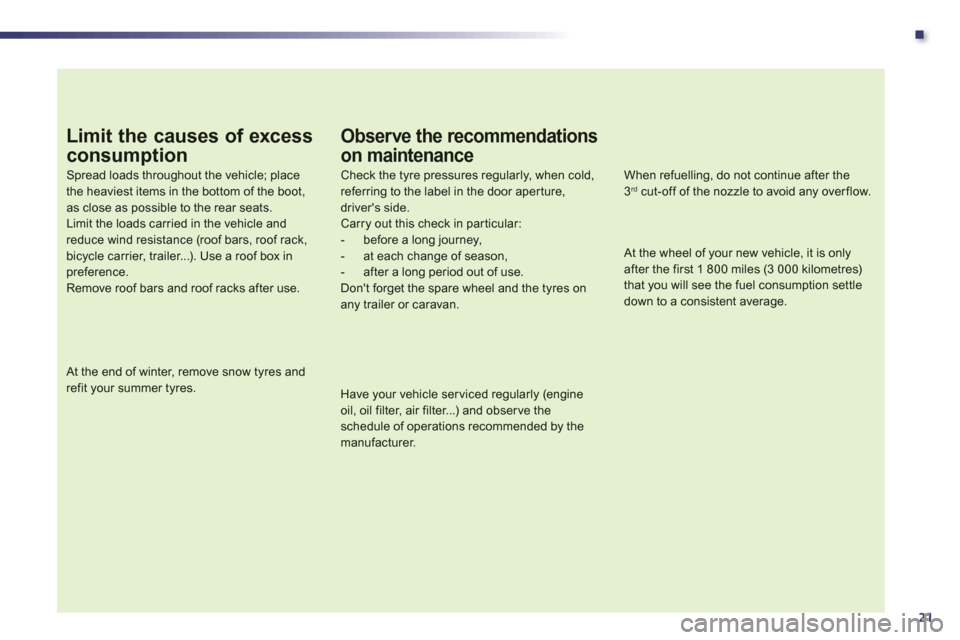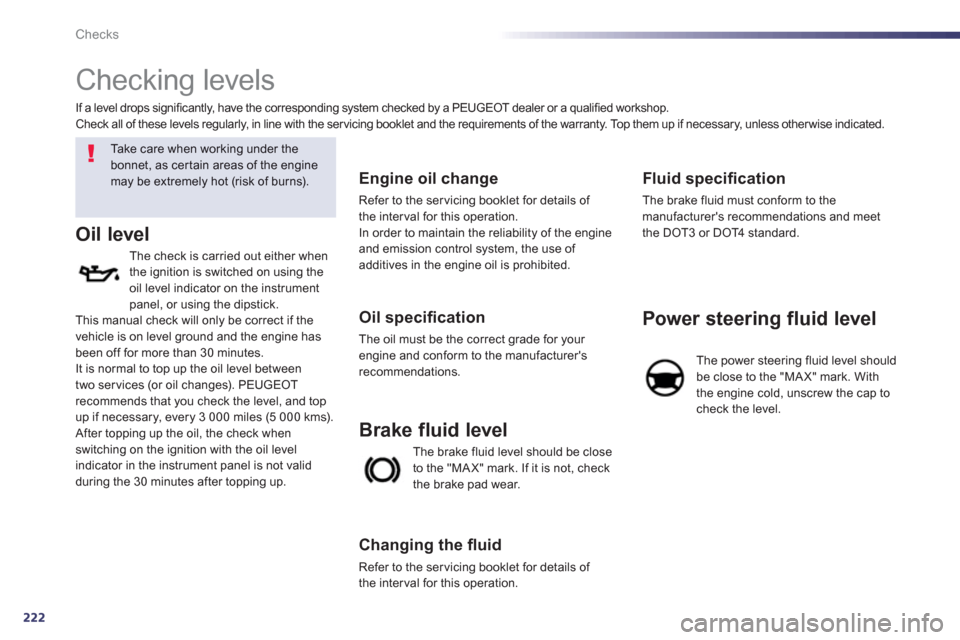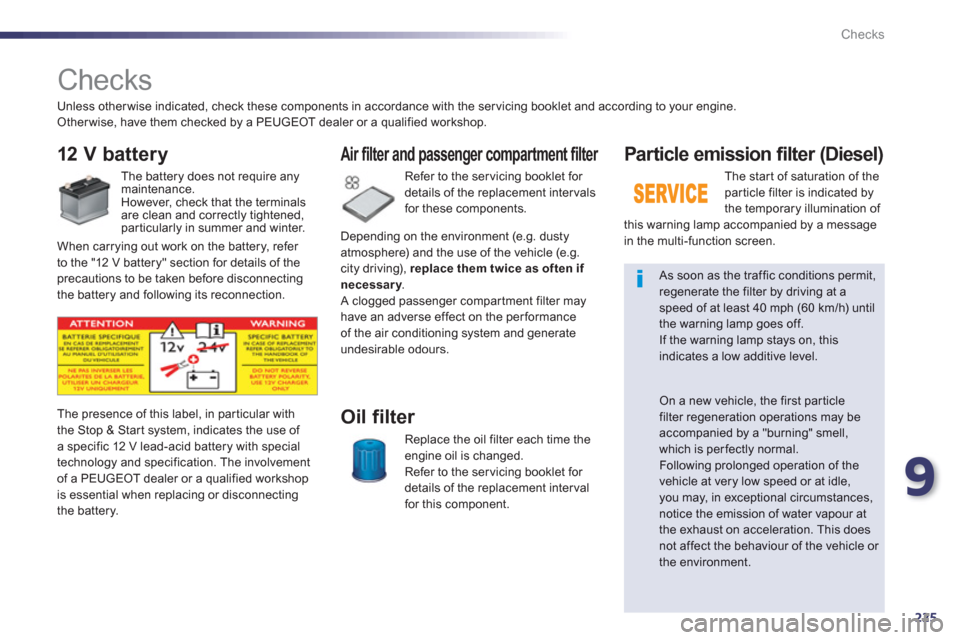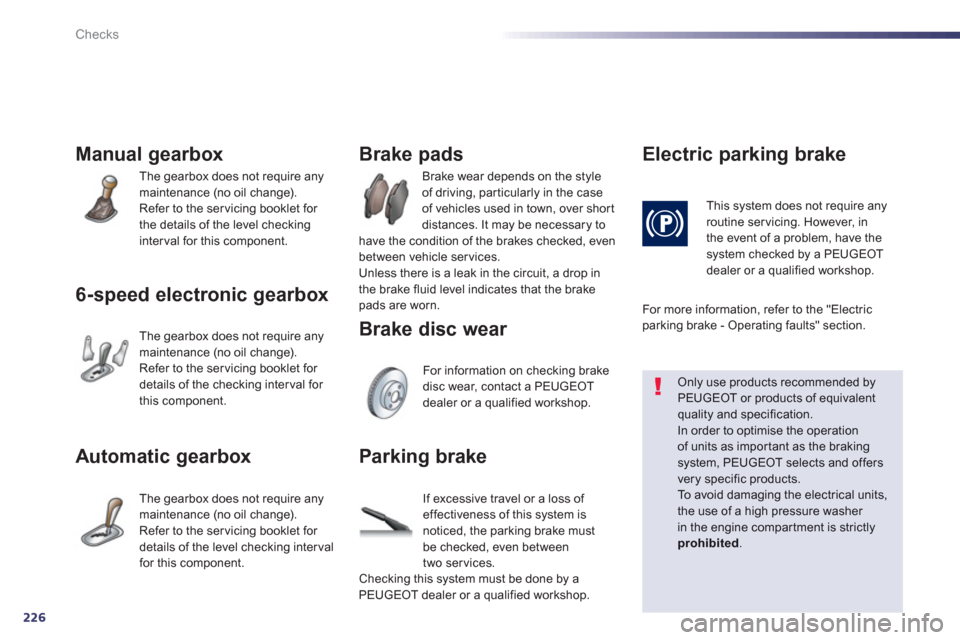2013 Peugeot 508 Hybrid oil change
[x] Cancel search: oil changePage 23 of 340

.
21
Limit the causes of excess
consumption
Spread loads throughout the vehicle; placethe heaviest items in the bottom of the boot,as close as possible to the rear seats.Limit the loads carried in the vehicle and reduce wind resistance (roof bars, roof rack, bicycle carrier, trailer...). Use a roof box inpreference.Remove roof bars and roof racks after use.
At the end of winter, remove snow tyres and refit your summer tyres.
Observe the recommendations
on maintenance
Check the tyre pressures regularly, when cold, referring to the label in the door aper ture, driver's side.Carry out this check in par ticular:- before a long journey,- at each change of season,- after a long period out of use. Don't forget the spare wheel and the tyres onany trailer or caravan.
Have your vehicle ser viced regularly (engine oil, oil filter, air filter...) and obser ve the schedule of operations recommended by the
manufacturer.
When refuelling, do not continue after the3 rd
cut-off of the nozzle to avoid any over flow.
At the wheel of your new vehicle, it is only after the first 1 800 miles (3 000 kilometres) that you will see the fuel consumption settledown to a consistent average.
Page 224 of 340

222
Checks
Checking levels
Ta k e c a r e w h e n w o r k i ng under the
bonnet, as certain areas of the enginemay be extremely hot (risk of burns).
Oil level
The check is carried out either when
the ignition is switched on using the oil level indicator on the instrument panel, or using the dipstick.
This manual check will only be correct if the
vehicle is on level ground and the engine has
been o
ff for more than 30 minutes.
It is normal to top up the oil level between
two ser vices
(or oil changes). PEUGEOTrecommends that you check the level, and top
up if necessary, every 3 000 miles (5 000 kms).
After topping up the oil, the check whenswitching on the ignition with the oil levelindicator in the instrument panel is not validduring the 30 minutes after topping up.
Engine oil change
Refer to the ser vicing booklet for details ofthe inter val for this operation.
In order to maintain the reliability of the engine
and emission control system, the use of
additives in the engine oil is prohibited.
Oil specifi cation
The oil must be the correct grade for your engine and conform to the manufacturer'srecommendations.
Th
e brake fluid level should be close
to the "MA X" mark. If it is not, check
the brake pad wear.
Brake fluid level
Changing the fl uid
Refer to the ser vicing booklet for details ofthe inter val for this operation.
Fluid specifi cation
The brake fluid must conform to themanufacturer's recommendations and meet
the DOT3 or DOT4 standard.
Power steering fluid level
The power steering fluid level shouldbe close to the "MAX" mark. With
the engine cold, unscrew the cap to
check the level. I
f a level drops significantly, have the corresponding system checked by a PEUGEOT dealer or a qualified workshop. Check all of these levels regularly, in line with the ser vicing booklet and the requirements of the warranty. Top them up if necessary, unless other wise indicated.
Page 227 of 340

9
225
Checks
Checks
12 V battery
The battery does not require anymaintenance.
However, check that the terminals
are c
lean and correctly tightened,
particularly in summer and winter.
Refer to the servicin
g booklet for
details of the replacement inter vals
for these components.
Air filter and passenger compartment filter
Replace the oil filter each time theengine oil is changed.
Refer to the servicing booklet for
details of the replacement inter val
for this component.
Oil filter The presence of this label, in par ticular with
the Stop & Star t system, indicates the use of
a specific 12 V lead-acid battery with special
technology and specification. The involvement
of a PEUGEOT dealer or a qualified workshop
is essential when replacing or disconnecting
the battery.
Par ticle emission filter (Diesel)
The start of saturation of thepar ticle filter is indicated by
the temporary illumination of
this warning lamp accompanied by a message
in the multi-function screen.
As soon as the traffic conditions permit, regenerate the filter by driving at aspeed of at least 40 mph (60 km/h) until the warning lamp goes off.
If the warning lamp stays on, thisindicates a low additive level.
On a new vehicle, the first particlefilter regeneration operations may beaccompanied by a "burning" smell,which is perfectly normal.
Following prolonged operation of thevehicle at very low speed or at idle, you may, in exceptional circumstances, notice the emission of water vapour atthe exhaust on acceleration. This does not affect the behaviour of the vehicle or the environment.
Unless other wise indicated, check these components in accordance with the ser vicing booklet and according to your engine.
Other wise, have them checked by a PEUGEOT dealer or a qualified workshop.
When carr
ying out work on the battery, refer
to the "12 V battery" section for details of theprecautions to be taken before disconnecting
the battery and following its reconnection.Dependin
g on the environment (e.g. dustyatmosphere) and the use of the vehicle (e.g.city driving), replace them twice as often if necessary.y A clogged passenger compartment filter may have an adverse effect on the performance
of the air conditioning system and generateundesirable odours.
Page 228 of 340

226
Checks
Manual gearbox
The gearbox does not require any
maintenance (no oil change).
Refer to the servicing booklet for
the details of the level checkinginterval for this component.
6-speed electronic gearbox
The gearbox does not require any
maintenance (no oil change).
Refer to the servicing booklet for
details of the checking inter val for
this component.
Automatic gearbox
The gearbox does not require any
maintenance (no oil change).
Refer to the ser vicing booklet for
details of the level checkin
g interval
for this component. Brake wear depends on the st
yle
of driving, par ticularly in the case
of vehicles used in town, over shor t
distances. It ma
y be necessary to
have the condition of the brakes checked, even between vehicle services.
Unless there is a leak in the circuit, a drop in
the brake fluid level indicates that the brake pads are worn.
Brake pads
For information on checking brake
disc wear, contact a PEUGEOT
dealer or a qualified workshop.
Brake disc wear
Electric parkin
g brake
This system does not require any routine servicing. However, in
the event of a problem, have the
system checked by a PEUGEOT
dealer or a qualified workshop.
Only use products recommended by PEUGEOT or products of equivalentquality and specification. In order to optimise the operationof units as impor tant as the braking system, PEUGEOT selects and offersvery specific products.
To a v o i d d a m aging the electrical units,the use of a high pressure washer in the engine compar tment is strictly
prohibited.
Parking brake
If excessive travel or a loss of effectiveness of this system isnoticed, the parking brake must
be checked, even between
tw
o services.
Checking this system must be done by aPEUGEOT dealer or a qualified workshop.
For more information
, refer to the "Electric parking brake - Operating faults" section.